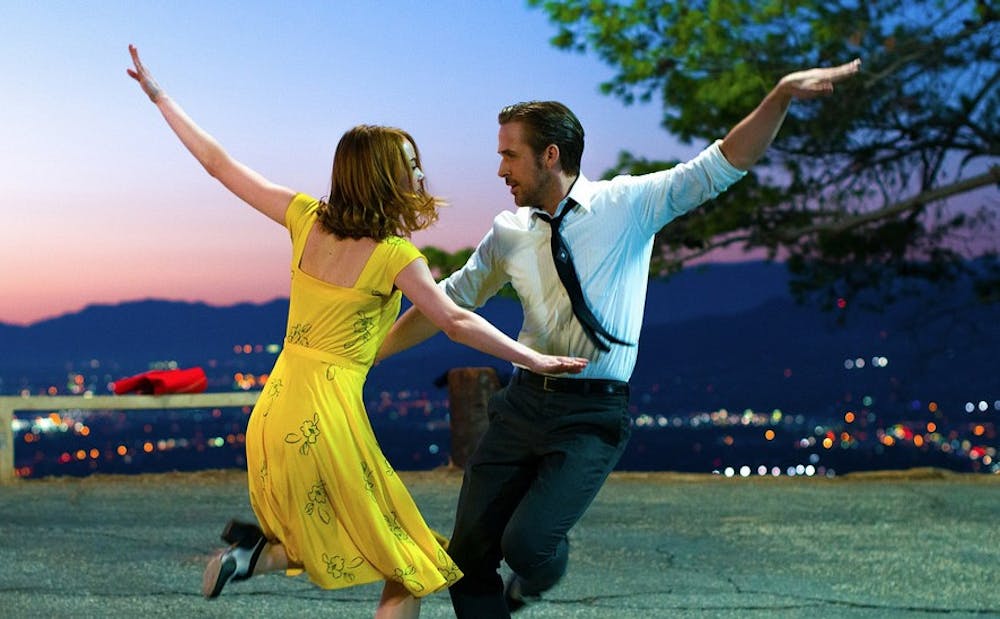When the world last saw the handiwork of Damien Chazelle, it was in an exhilarating, ten-plus-minute drum performance that capped off 2014’s “Whiplash.” The extended tension and release of that final scene, buoyed by a restless camera, stood out as the undoubted highlight of the film, and it showed Chazelle’s unique capabilities as a director. When given the chance to let the music take over, he does not disappoint.
It was only natural, then, that Chazelle would choose to direct a “musical” in the classic sense of the word—a movie with the kind of spontaneous song-and-dance routines that leave some portions of modern audiences squirming in their seats. With Oscar-frontrunner “La La Land,” he wastes no time delivering on this potential. Immediately setting an unapologetic, unironic tone, the film opens with gridlocked traffic on the Judge Harry Pregerson Interchange in L.A.—the city of dreamers referenced by the title—using a single tracking shot as, one by one, the pastel-wearing motorists take to the street for an all-out ensemble number. Just as suddenly, the traffic clears, the drivers get back in their cars, the honking resumes. Cue title card.
From there, the movie follows Mia (Emma Stone) and Sebastian (Ryan Gosling), who, after a prickly start, find themselves drawn to each other for their respective passions: Mia hopes to make it as an actress, while Sebastian dreams of owning a jazz club. Both are dreamers in a city full of them, and we meet them far from their goals—Mia’s fruitless auditions conflict with her shifts at the coffeeshop, and self-described “serious musician” Sebastian nevertheless finds himself playing keytar in an ‘80s cover band.
Through the lens of Mia and Sebastian’s romance, we see Los Angeles elevated to the romantic heights of classical cities like New York and Paris (something Chazelle has talked about at length). The L.A. the protagonists inhabit is a surreal one, where lovers literally dance through the air, and this duality between fantasy and reality—playing into the very format of a musical—drives the film, as its characters try to reconcile their high-flown aspirations with unpaid utility bills, inflexible bosses and, most of all, close relationships.
It’s impossible to talk about “La La Land,” though, without giving due diligence to its forebearers. The film does not shy away from callbacks to cinema’s golden age: the title card reads “presented in CinemaScope,” while tap-dance duets and dream ballets recall “Singin’ in the Rain” and “An American in Paris.” Chazelle has also spoken of his fondness for French director Jacques Demy, the mind behind musicals like “The Umbrellas of Cherbourg.” This influence is evident in “La La Land”’s brightly-colored dresses, meta commentary on cinema and sometimes absurd indulgence in extravagant choreography.
As absurd as Chazelle’s L.A. may be, “La La Land” is always grounded in realism. Emma Stone and Ryan Gosling are by no means perfect singers, but their vocals lend a refreshing dose of humanity to their characters. Songs often start with a whistle, a hum, a whisper in the mirror, only emphasizing Mia and Sebastian’s uncertainty in what lies ahead. They are above all relatable for their aspirations—one gets the feeling that Chazelle could have built a film around anyone in that opening traffic jam.
It is this nature of realism that distinguishes the film from its many influences, making it more than a mere vessel for rose-colored nostalgia toward a more traditional time. Songs and dances function as reflections of the characters’ fantasies—of longing, of falling in love, of chasing dreams. This may explain why the middle section, where the mundane stresses of adult relationships take over the plot, is all but music-free (even if the film’s pacing suffers for it).
But just as he did in “Whiplash,” Chazelle shines once more in a brilliant final act, more than making up for that lull. With the help of composer Justin Hurwitz, who wrote much of the soundtrack for “Whiplash,” and lyricist duo Pasek and Paul, Chazelle crafts a memorable score that culminates in an awe-inspiring final number.
With pop culture as compartmentalized as it is today, it’s hard to imagine a tune from “La La Land”—or, for that matter, any modern original musical—becoming a standard in the vein of, say, “Singin’ in the Rain” or “Over the Rainbow.” Yet Hurwitz, Pasek and Paul’s music delivers enough earworms to invite re-listens. In particular, the recurring “City of Stars” may go down as a classic duet (and at the time of print has already secured a Golden Globe win for best original song) and the melancholy piano of “Mia and Sebastian’s Theme” anchors the film with an emotional and narrative motif.
Like the best Jacques Demy musical, “La La Land” hides under every joyful dance and saturated color an underlying melancholy. For every moment of delight in the film, there’s one of heartache. By conjuring these emotions in the form of music and dance, Damien Chazelle does with “La La Land” what no Hollywood movie has done in quite some time.
Get The Chronicle straight to your inbox
Signup for our weekly newsletter. Cancel at any time.

